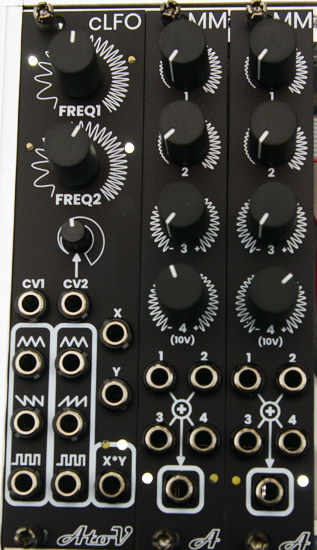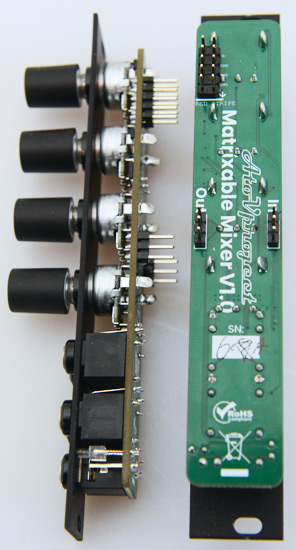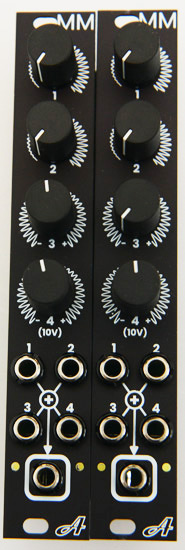AtoVproject cLFO and MMx2
Modulation Utility Eurorack Modules
Author and photos: Peter Kaminski
We have already presented the cDVCA from AtoVproject in a test, a very special VCA for sound shaping. At SuperBooth 2024, the Berlin-based module manufacturer presented two modules for modulation, namely the voltage-controlled dual LFO "cLFO" and the matrix mixer duo "MMx2" - again modules that go beyond the functionality of their thematic counterparts.
cLFO
Let’s first examine the cLFO, which offers two voltage-controlled LFOs with different waveforms to the user.
The operating current of the 6-HP wide module is relatively low at 49mA peak (+12V) or 57mA peak (-12V). The front panel is made of aluminium. The module is available with either a black or silver front panel.
Triangle, sawtooth (LFO1 descending, LFO2 ascending), and square waveforms are available as outputs. The frequency of the two LFOs can be set via a controller in the range of two minutes per cycle up to 20Hz. If a CV is applied, the frequency can be reduced further and also increased up to 400Hz. There is a 3.5-mm TRS socket for voltage control for each LFO. If no plug is inserted in the CV2 socket, the triangle output of the first LFO is routed to CV2. The modulation degree can be adjusted using a potentiometer (in both cases, internal routing or external routing).
A four-quadrant multiplier (ring modulator) is also integrated. Without wiring, the triangle output of LFO1 is switched to the X input, and the sawtooth output of LFO2 is switched to the Y input. The output, which can accept both positive and negative voltages, is available at the XY socket. When a jack plug is inserted into X or Y, the internal connection is interrupted.
MMx2
The second module, or better said modules, which were shown at the SuperBooth 2024 by AtoVproject, are four-channel control voltage mixers, whereby audio signals can also be mixed, but it is functionally optimised for mixing control signals. The MM module has a width of 4 HP. Here too, the front panels are made of aluminium and are available in black or silver. The MMx2 is supplied as a duo, and both MM modules are identical.
However, several mixers can also be cascaded. Cascading is realised via a three-wire cable. For this purpose, the modules each have an In- and Out- terminal strip (see illustration above) on the rear of the circuit board. Two connection cables for module connection are provided with the Duo. For cascading, the Out port of the first mixer must be connected to the In port of the second mixer. The operating current is 10mA (+12V) or 8mA peak (-12V) per module.
There are four inputs per mixer. The first two are equipped with attenuator control. At the left stop position, the attenuation is maximum. With the other two controls, the greatest attenuation is obtained at control position 12 o’clock. The voltage is mixed positively to the right and negatively to the left of 12 o'clock (signal inversion). When not connected, input 4 has the special feature that a +/-10 volt offset voltage is added, depending on the controller position. This is negative to the left of the 12 o’clock position and positive to the right. If mixers are cascaded, outputs 1, 2, and 3 are sent to the next MM mixer module via the connecting cable.
Practice

First to the LFO. The separate outputs also make it possible to control the LFO frequency via its own naturally frequency-identical output waveform. This allows you to create a wide variety of other waveforms, for example, by connecting the sawtooth output of LFO2 to the CV2 input. The waveform can then be changed smoothly using modulation level control. Delayed use of the LFO with increasing LFO level is also possible via the four-quadrant multiplier by connecting a corresponding envelope signal to the Y input. This then turns LFO1 at output XY into a delayed LFO (without any further wiring), just like the Doepfer A-147-2.

The mixer is an ideal combination of attenuator (In 1/2), amplifier/inverter (In 3/4), and sum voltage offset adjustment (via control 4 without using socket 4). You cannot have enough of these modules. It is often not possible to set control voltage-dependent parameters on the module itself. Wavetable controls are a classic example. These often have far too much excursion and sound accordingly. Here, attenuation helps, and the nominal position in the wavetable can then be set via offset control. For many parameters that influence the sound of digital oscillators or effect modules, it can also make sense to invert the control signal. All of this can be achieved using the MM modules. For those who want to link a large number of control signals, cascading to a matrix mixer can also lead to the desired result.
Conclusion
The price for the AtoVproject cLFO module is 225 euros for a finished module. It can also be purchased for 190 euros as a DIY kit. The online documentation for the DIY kit is a step-by-step guide that you can't really go wrong with. Absolutely suitable for beginners. The matrix mixer pair costs 190 euros and is also available as a DIY device for 160 euros. The modules are available as ready-made devices both directly from the AtoV website via their online store and from Schneider’s store. The kits can be ordered from the AtoVprojects online store and from Exploding Shed.
The cLFO is a very flexible module, and with only 6 U, it is also space-saving. The multiplier and internal pre-wiring enhance the dual LFO. The MMx2 can do what the Befaco dual attenuverter module does, for example, but it also offers a four-channel mixer that can also be cascaded, making it more flexible.
Both are interesting little helpers that are useful in everyday practise and are also reasonably priced and very well made.
 How to resolve AdBlock issue?
How to resolve AdBlock issue? 



